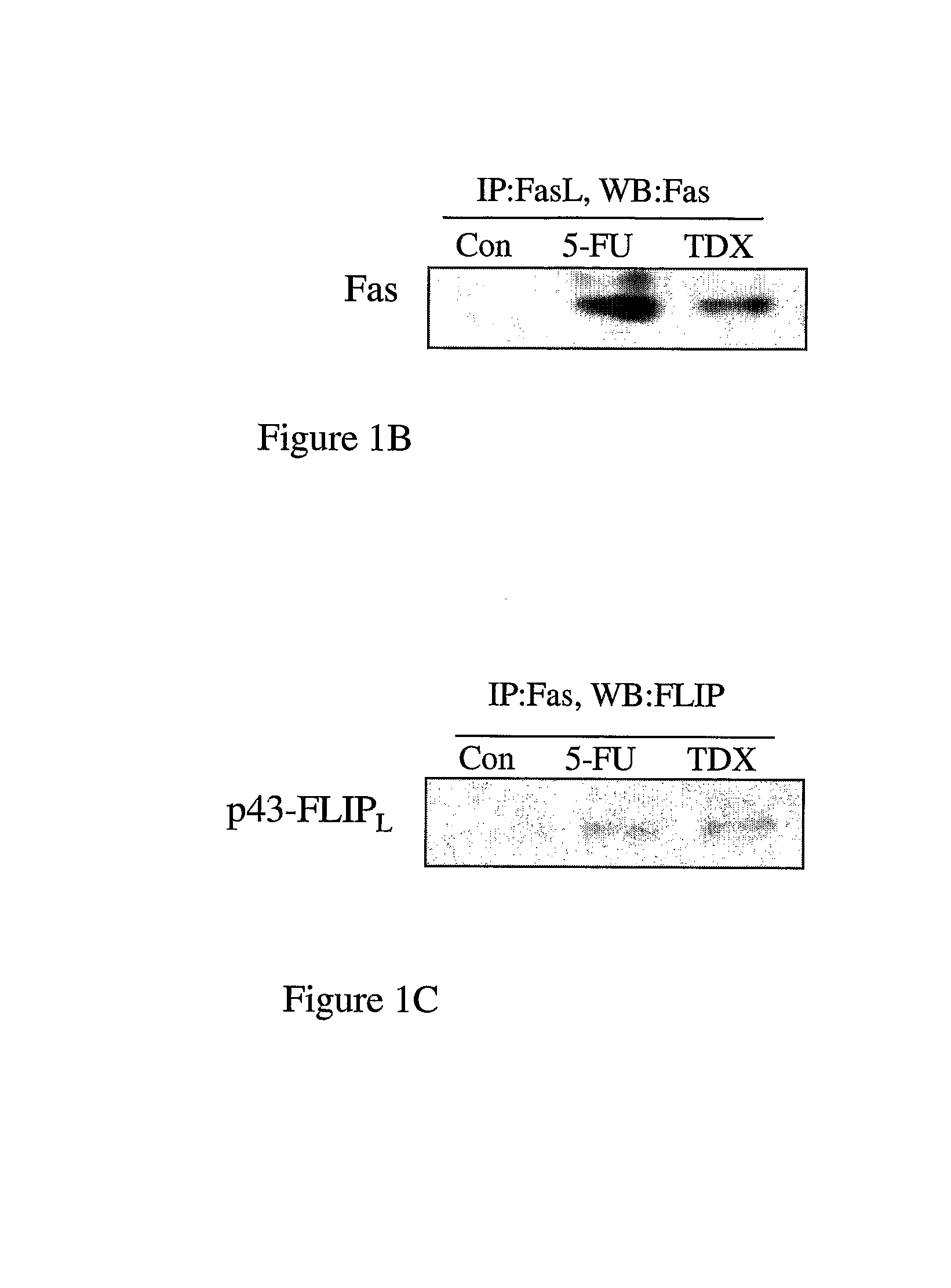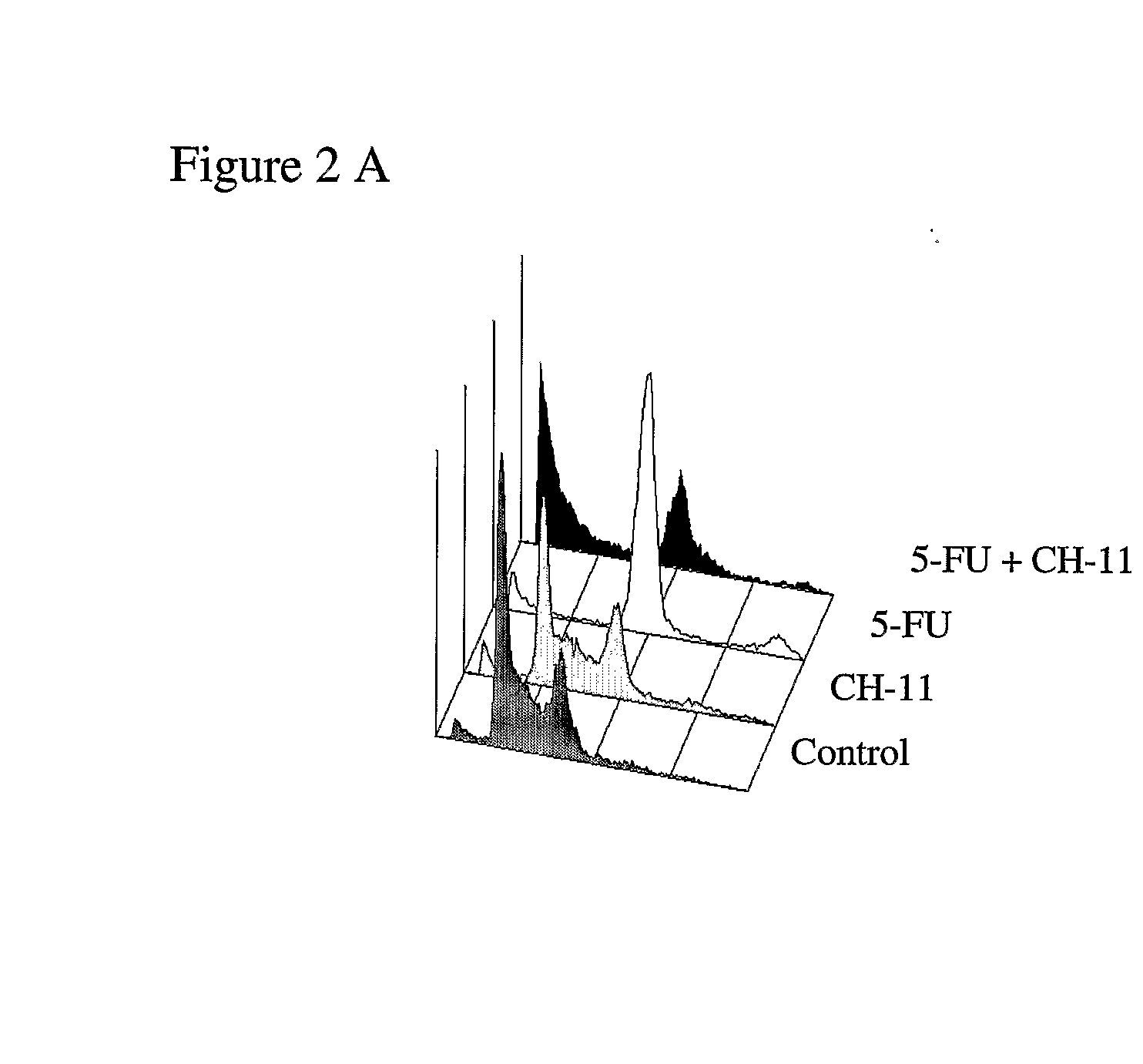Cancer Treatment
a technology for cancer and treatment, applied in the field of cancer treatment, can solve the problem of abrogating the synergistic effect achieved
- Summary
- Abstract
- Description
- Claims
- Application Information
AI Technical Summary
Benefits of technology
Problems solved by technology
Method used
Image
Examples
example 1
c-FLIPL is Up-Regulated, Processed and Bound to Fas in Response to 5-FU and TDX
[0146]Analysis of Fas expression in MCF-7 cells revealed that it was up-regulated by ˜12-fold 72 hours after treatment with an IC60 dose 5-FU and was also highly up-regulated (by ˜7-fold) in response to treatment with an IC60 dose (25 nM) of TDX (FIG. 1A). FasL expression was unaffected by each drug treatment, but appeared to be highly expressed in these cells. Expression of FADD was also unaffected by drug treatment. Somewhat surprisingly, neither caspase 8, nor its substrate BID were activated in 5-FU- or TDX-treated cells as indicated by a lack of down-regulation of the levels of procaspase 8 or full-length BID (FIG. 1A). Bcl-2 was highly down-regulated in response to each agent. Interestingly, c-FLIPL but not c-FLIPS was up-regulated by drug treatment. Furthermore, c-FLIPL was processed to its p43-form indicative of its recruitment and processing at the DISC (FIG. 1A). Expression of the Fas decoy rece...
example 2
Activation of Drug-Induced Apoptosis by the Fas-Targeted Antibody CH-11 Coincides with Processing of c-FLIPL
[0148]Expression of FasL by activated T cells and NK cells induces apoptosis of Fas expressing target cells in vivo. To mimic the effects of these immune effector cells in vitro, the agonistic Fas monoclonal antibody CH-11 was used. Cells were treated with either 5-FU or TDX for 72 hours followed by 250 ng / ml CH-11 treatment for 24 hours. We found that CH-11 alone had little effect on apoptosis (FIGS. 2A and B). Treatment with 5-FU alone for 96 hours resulted in a modest-2-fold induction of apoptosis in response to 5 μM 5-FU (FIG. 2A). However, addition of CH-11 to 5-FU-treated cells resulted in a dramatic increase in apoptosis, with a ˜55% of cells in the sub-G1 / G0 apoptotic phase following co-treatment with 5 μM 5-FU and CH-11. Similarly, the combination of TDX with CH-11 resulted in dramatic activation of apoptosis, with ˜60% of cells in the sub-G1 / G0 apoptotic phase follo...
example 4
Overexpression of c-FLIPL Inhibits Chemotherapy-Induced Fas-Mediated Cell Death
[0154]To further investigate the role of c-FLIPL in regulating Fas-mediated apoptosis following drug treatment, we developed a panel of MCF-7 cell lines overexpressing c-FLIPL. We developed cell lines with 5-10-fold increased c-FLIPL expression compared to cells transfected with empty vector (FIG. 4A). The c-FLIPL-overexpressing cell lines FL44 and FL64 and cells transfected with empty vector (EV68) were taken forward for further characterisation. Cell viability assays indicated that treatment of EV68 cells with 5-FU followed by CH-11 resulted in a highly synergistic decrease in cell viability (RI=2.06, pL overexpression in FL64 cells abrogated both activation of caspase 8 and PARP cleavage in response to 5-FU and CH-11 co-treatment (FIG. 4C).
[0155]We next examined the effect of c-FLIPL overexpression on Fas-mediated apoptosis following treatment with the antifolates TDX and MTA and the DNA-damaging agent...
PUM
| Property | Measurement | Unit |
|---|---|---|
| Fraction | aaaaa | aaaaa |
| Concentration | aaaaa | aaaaa |
| Ratio | aaaaa | aaaaa |
Abstract
Description
Claims
Application Information
 Login to View More
Login to View More - R&D
- Intellectual Property
- Life Sciences
- Materials
- Tech Scout
- Unparalleled Data Quality
- Higher Quality Content
- 60% Fewer Hallucinations
Browse by: Latest US Patents, China's latest patents, Technical Efficacy Thesaurus, Application Domain, Technology Topic, Popular Technical Reports.
© 2025 PatSnap. All rights reserved.Legal|Privacy policy|Modern Slavery Act Transparency Statement|Sitemap|About US| Contact US: help@patsnap.com



